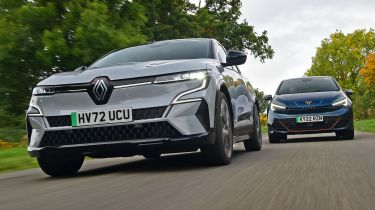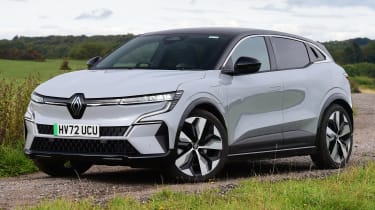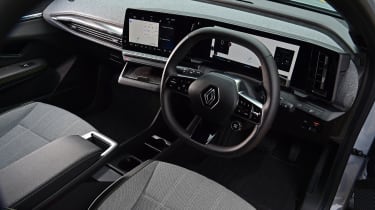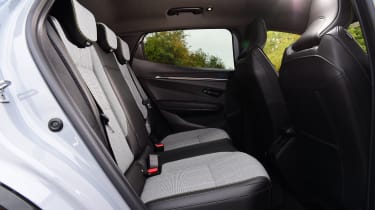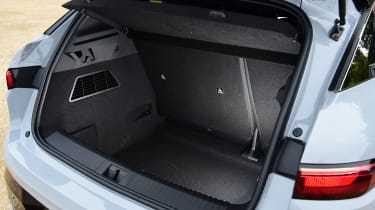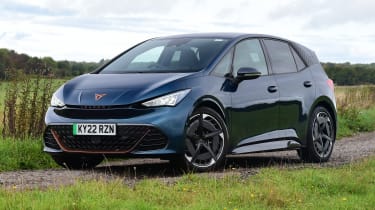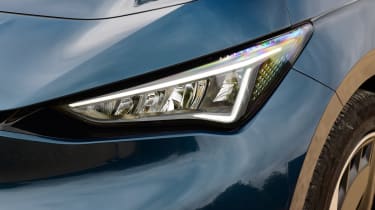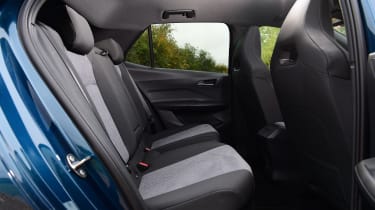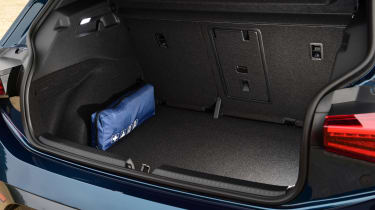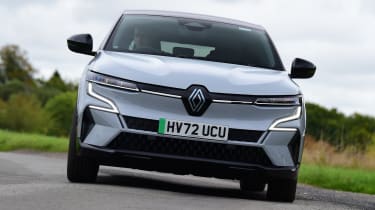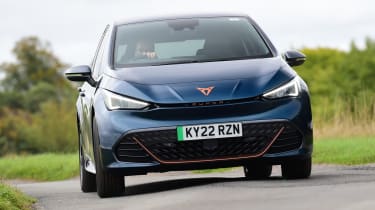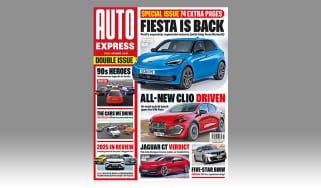Renault Megane E-Tech vs Cupra Born: 2022 twin test review
The Renault Megane goes electric – does it have an edge over the Cupra Born?
There aren’t many names that are more recognisable across the automotive landscape than Megane. Renault has been using the badge on its hatchbacks since the mid-nineties, when the first generation replaced the 19, and since then 1.3 million Meganes have been sold throughout Europe.
But now there’s an all-new model, and it’s gone electric. The Megane name now does without an accent and has the E-Tech badge attached, and the new model has a tough challenge ahead of it. It needs to establish itself all over again, and in the face of some old and new rivals.
Our early encounters have shown promise, and with a fairly low kerbweight by EV standards, it’s even quite sporty to drive. If Megane is one of the oldest names in the family hatchback class, then Born is among the newest. Cupra is SEAT’s performance-brand offshoot, and its entrant into the all-electric segment aims to add a little spice to the mix. This makes it the perfect foil for the Megane in this contest.
Can the Renault create enough impact in a class which seems to get busier and more overflowing with talent by the week? Or will the Cupra deliver enough driver involvement to help it top the segment?
Renault Megane E-Tech
Design & engineering
Used - available now

2020 BMW
1 Series
57,956 milesAutomaticPetrol1.5L
Cash £16,290
2020 Mercedes
E-Class Cabriolet
85,178 milesAutomaticDiesel2.0L
Cash £15,990
2022 Nissan
Qashqai
16,905 milesAutomaticPetrol1.3L
Cash £21,200
2024 Vauxhall
Mokka
20,828 milesManualPetrol1.2L
Cash £14,200Making the Megane into an EV seems like a logical step. Not only is the time right for electrification, but it’s also coming from a brand that knows a thing or two about electric cars. More than 400,000 Zoe superminis have been sold since its launch in 2012, and the Megane E-Tech builds on Renault’s experience with that model. It’s very much a next-generation EV and is the first model to wear the latest Renault logo, too, which is part of the brand’s “Renaulution” strategy.
The specs show that this really is a more advanced model than the Zoe. It rides on the same CMF-EV architecture as the Nissan Ariya, but there is diversion between this vehicle and our Car of the Year. For a start, the Megane is much smaller; in
fact, the Renault’s proportions are quite deceptive. From the pictures, its large wheels and slim glasshouse make it look almost SUV-sized, but it’s 122mm shorter than the Cupra and even 159mm shorter than the last combustion-powered Megane. It’s also 35mm lower than the Born, but 51mm wider.
Within that compact footprint, Renault has squeezed one of the slimmest batteries around, and it has a capacity of 60kWh. This energy is fed to a front-mounted motor, which produces 217bhp. EVs and their large batteries tend to be heavy, but Renault claims that at 1,685kg, the Megane is the lightest car in this segment. Larger body parts, including the doors, are made from aluminium to save weight.
Inside, the Megane looks smart and contemporary. There are some hard, scratchy plastics low down in the cabin, but the clever use of materials elsewhere, such as the fabric dash top, means that the bits that you look at and touch most often all feel expensive. The driving position has plenty of adjustment, but a tiny rear window means that rear visibility is poor.
Driving
One of the first things to strike you with the Megane is just how refined it is to drive. Tyre roar and suspension knocks are very well isolated from the cabin, which immediately makes it feel quite relaxing. The throttle pedal is easy to modulate, so being smooth at low speeds is no trouble at all. That’s as long as you leave the powertrain in normal mode, though; switch to Sport and the response becomes almost too sharp without actually improving performance.
Acceleration is strong, though. The 0-62mph sprint takes 7.5 seconds, although on damp surfaces the traction control will cut in under hard acceleration to prevent the front wheels from slipping.
The brakes have four levels of regeneration that can be tweaked on the fly through steering wheel-mounted paddles. This adds an extra dimension to the EV experience that is lacking in the Cupra, giving the driver more control when coasting down a hill or towards a junction. It’s just a shame that the brake pedal depresses automatically when this happens; Renault isn’t the only brand to do this, but it’s a really disconcerting feeling to cover the brake and then feel it disappear from under your foot.
The Megane’s ride is a little busy at slow speeds, but it’s never harsh, so it’s comfortable overall. This is combined with a chassis which feels reasonably agile, but isn’t quite as fun to drive as the Cupra.
Practicality
The ground-up EV platforms of each of these cars mean that, compared with similarly sized combustion-engined cars, they’re far more spacious inside. Both models are big enough for family life, and they offer near-identical levels of room for rear passengers.
The key difference is that the Cupra’s floor feels slightly lower; in the Megane, taller passengers will have their thighs lifted away from the squab slightly, which will make the seats less supportive on longer journeys. The middle seat is fairly narrow, but it is soft and comfortable. Isofix mounting points are easily accessible in both cars.
At 440 litres, the Megane’s boot is impressive. The space is very deep, so it’s great for holding bulky items, but getting them in is a challenge, because the load lip is very high. The tiny button to open the hatch is a little awkward, too.
Ownership
Renault’s warranty is much more comprehensive than Cupra’s. The French brand covers the Megane for five years and 100,000 miles, compared with three years and 60,000 miles for the Born. Three years’ worth of breakdown cover is one year more than Cupra provides, too.
One concern is Renault’s Driver Power rating; in 2022 it finished a disappointing 24th overall. Cupra wasn’t rated, but fellow Spanish brand SEAT, with which it shares some models and its dealer network, finished higher – but still not brilliantly – in 17th.
Running costs
These cars will both be an ideal choice for company car users, because they fall into the lowest possible two-per cent Benefit in Kind band. For a higher-income earner, that means Megane users will face deductions of just £308 each year, while it’s £349 for the Cupra.
Depreciation is a more important factor for private buyers, and here it’s the Cupra which is the better choice. After three years or 36,000 miles, it’s expected to hold 62.3 per cent of its value, compared with 57.4 per cent for the Renault.
Our only small gripe with the Megane is its range. That fairly modest battery means that it can’t go as far as its rival on a single charge; our 3.7mi/kWh rating translates into a real-world range of 222 miles, 78 miles less than the Born’s.
Testers’ notes: “The column-mounted gear selector sits just above the wiper stalk. It’s a bit too close, so it’s easy to knock the wrong one by accident.”
| Model: | Renault Megane E-Tech 60kWh Techno |
| Price: | £38,495 |
| Powertrain: | Single e-motor, 60kWh battery, 217bhp |
| 0-62mph: | 7.5 seconds |
| Test efficiency: | 3.7mi/kWh |
| Charge speed: | 130kW (15-80% in 30 mins) |
Cupra Born
The Born is more expensive than the Megane, with this top-spec V3 weighing in at £43,735. This car’s extras include the lovely Aurora Blue paint (£880) and the Tech (M) Pack (£540), which adds intelligent park assist, Car 2X vehicle networking, wireless smartphone charging and keyless entry, lifting the total to £45,155.
Design & engineering
These cars compete within the same space of the market, and each makes use of a dedicated EV platform, but the engineering decisions taken to produce them are fundamentally different. While the Megane has a single motor driving the front wheels, the Born, which rides on the same Volkswagen Group MEB architecture as the VW ID.3, Audi Q4 e-tron and Skoda Enyaq iV, has a motor set low down over the back axle and sending torque to the rear wheels.
View it from the side, and the Born looks very similar to the aforementioned ID.3; only the Cupra-specific wheels and colours set the two apart. The changes come at the front and rear; while the ID.3 has gone for a soft, almost friendly look, the Born instead goes for a sharper, more sporty appearance, with slim, pointy lights and Cupra’s signature copper-coloured highlights.
The basic layout inside is much the same as the VW’s, too, and ‘basic’ is the key word there, because the design looks much more spartan than the Renault’s. There are some odd ergonomic choices, too. The dual-function electric window switches, which require you to press a touch-sensitive key to choose either front or rear opening, are just daft, while the sliding climate and volume controls, which don’t light up at night, are very fiddly.
But while the cabin feels cheaper than the Renault’s, the key component that justifies the Born’s extra cost above its rival is the battery. A 77kWh usable capacity means it’s 17kWh larger than the Megane’s unit. A smaller 58kWh battery is also available in the Cupra. With 227bhp and 310Nm, the Born can boast slightly more power and torque than the Renault, but that battery means that it weighs more than 1.9 tonnes, so it’s also much heavier.
Driving
Even though Cupra is pitched as a sporting brand, we’d stop short of calling the Born a hot hatch. Yes, body roll is fairly well controlled in corners, the rear-wheel-drive layout delivers a sweet balance when accelerating out of them, and there’s slightly more grip than in the Renault, but it’s still not a hugely engaging car to drive. It feels a little too lethargic – the car’s weight can’t be hidden completely – and while the steering is accurate, it’s too inert to provide engagement.
To keep roll to a minimum, the suspension needs to be firm, and that’s only too apparent as soon as you travel along expansion joints, over potholes or generally most uneven surfaces. As with the Renault, it manages to take the edge off the worst bumps, so it never feels harsh, but the constant fidget might be irritating if you do lots of driving in town.
The Born covers the 0-62mph sprint in seven seconds exactly, which is half a second quicker than the Megane. But in the real world, the difference is hardly noticeable. The Cupra’s power delivery is very smooth, though, and the motor is near-silent in its operation.
Sportier driving modes sharpen up the throttle response, but even in these settings, it’s easier to modulate the pedal than in the Renault. It’s just a shame that there are only two regenerative braking settings; the stronger mode can be accessed by selecting ‘B’ on the neat instrument binnacle-mounted gear selector.
Practicality
As we’ve already established, both cars serve up plenty of space for occupants, but the Cupra’s rear-mounted motor means the Born’s boot is a little smaller than the Megane’s. Still, at 385 litres, it’s a match for combustion-engined hatchbacks like the VW Golf.
Charging £340 for a false boot floor, bundled in with a 2.3kW charge cable, seems a little mean in a near-£45,000 car, though. Without it, there’s quite a pronounced hump in the floor when you drop the seat backs down.
On the whole, storage within the cabin is great, though. The front door bins are huge, there’s a deep centre bin under the central armrest, and another further forwards which also has two cup holders. The only small negative is the glovebox, which is effectively halved in size because of the location of the fuse box.
Although passenger space is similar to its rival, the Born has a little more foot space under the front seats. Our car, however, was a strict four-seater: there was no middle seatbelt. But other Borns are available with a three-seat rear bench.
Ownership
Both the Born and Megane E-Tech were assessed by Euro NCAP in 2022, and were therefore tested to the same standards. They each earned a five-star rating, but dive into the individual scores, and the Cupra slightly outperformed the Renault across the board. It offered better protection to adults and children inside the car, and vulnerable road users outside, plus it scored higher for its driver-assist tech.
Running costs
One area where the Born scores very impressively is its efficiency. We averaged 3.9 miles per kWh on test, but in the right conditions and with more town driving, that figure will easily improve. In mixed driving, the Megane managed 3.7mi/kWh.
Over the course of 20,000 miles, that’s the difference between charging costs of £1,436 for the Cupra and £1,514 for the Renault. The gap will only widen if you rely on costlier public chargers.
Tester’s notes: “Four years on from becoming a standalone brand, and I still haven’t figured out that Cupra logo. It all looks a bit ‘Space Invaders’ to me.”
| Model: | Cupra Born 77kWh e-boost V3 |
| Price: | £43,680 |
| Powertrain: | Single e-motor, 77kWh battery, 228bhp |
| 0-62mph: | 7.0 seconds |
| Test efficiency: | 3.9mi/kWh |
| Charge speed: | 135kW (5-80% in 36 mins) |
Results
First place: Renault Megane E-Tech
The Megane takes the win because we’re impressed with its skills right across the board.
It’s very spacious and practical for a car with such a modest footprint, it’s decent to drive and delivers strong refinement. The infotainment tech is some of the very best in any new car right now. Throw in competitive monthly payments, and it’s cracking value for money, too.
Second place: Cupra Born
While it can’t quite match the Megane when it comes to the finances or in-car tech, the Cupra still has plenty going for it. It’s among the sharper EV hatchbacks to drive, and is still more than spacious enough for family car buyers. The range and efficiency are excellent – factors that are more important than ever with rising energy costs – but a fidgety ride compromises overall comfort.
Four alternative electric hatchbacks
Citroen e-C4
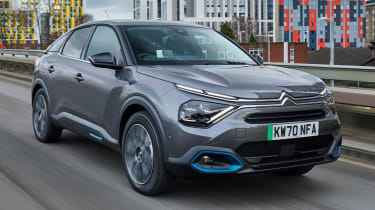
- Model: Shine Plus
- Price: £32,995
- Powertrain: Single e-motor, 50kWh battery, 134bhp
If the Megane doesn’t offer enough French quirkiness for you, then the e-C4 might be the perfect alternative. True to recent Citroen form, distinctive styling is there in abundance.
But there’s more to the e-C4 than its looks. It uses Advanced Comfort tech, which includes supportive seats and hydraulic bump stops in the suspension, so the e-C4 delivers a comfortable and relaxed drive - one that complements the silence of the electric motor.
In this company, it’s a little down on power and range – officially it’s capable of 219 miles – but it will be fine for most needs. If you need to go further, 100kW charging means that the smaller battery doesn’t take too long to top up.
The flipside to the e-C4’s modest EV tech is a competitive price, while top-spec Shine Plus trim features a long kit list including 18-inch alloys, wireless smartphone charging and built-in nav.
Kia Niro EV
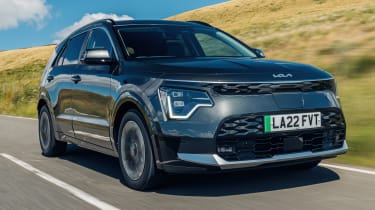
- Model: Niro EV 3
- Price: £38,940
- Powertrain: Single e-motor, 65kWh battery, 201bhp
Kia is building up a desirable range of electric vehicles, ranging from the striking Soul EV to the brilliant EV6. The Niro EV occupies the space between them, and the Mk2 is another hit. On paper, it’s hard to see where the improvements have been made; both the battery and motor power are almost identical to its predecessor.
The big improvements have come pretty much everywhere else. The new model is slightly larger than before, so there’s more space inside and a roomy 475-litre boot. The cabin looks (and feels) like a massive step forward over the old e-Niro, and Kia’s latest infotainment tech is still among the slickest around.
On the road, the new model is impressively refined. The ride quality is on the softer side, so for the most part it cushions its occupants from the worst road surfaces nicely. A 285-mile WLTP range is great, but relatively slow 72kW charging is disappointing.
MG4

- Model: Trophy Long Range
- Price: £31,495
- Powertrain: Single e-motor, 64kWh battery, 200bhp
Of these four rivals, the MG4 provides the sternest competition for the Megane, because it’s staggeringly good value. It’s the first car in MG’s UK line-up with a dedicated EV platform, and like the Renault and Cupra, this brings packaging benefits; there’s plenty of space inside for people, although the 363-litre boot is a little smaller than the Born’s. The cabin itself feels a little cheap in some places, but there’s plenty of standard kit.
Comfort is a very much priority for the MG4. The ride is soft on the move, but a little body roll and quick steering mean it’s still quite fun to drive. Performance is close to the Megane’s and the Born’s, with 200bhp and a 7.9-second 0-62mph time. Energy comes from a 64kWh battery, and there’s 135kW charging. Prices start from £25,995 for a 51kWh-battery car, but even the highest-spec model only comes in at £31,495, undercutting everything else here.
Volkswagen ID.3
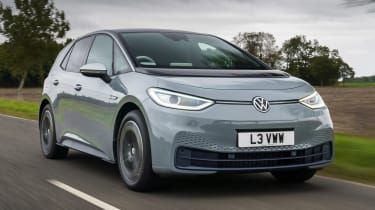
- Model: ID.3 Life
- Price: £36,990
- Powertrain: Single e-motor, 58kWh battery, 201bhp
The Born is a sportier take on the VW Group’s MEB platform, but the related nature of the ID.3 brings its own benefits. Whereas its Spanish cousin can feel a little unsettled over some surfaces, the ID.3 is more comfortable and relaxing to drive.
Elsewhere, it boasts similar strong points to the Cupra; there’s loads of space inside, and great visibility out. Currently there’s just one ID.3 variant on offer; the Life comes with a 58kWh battery and a 201bhp electric motor. As standard, it gets LED headlights, keyless entry and go, but no alloy wheels. It also features VW’s Discover Pro navigation system; this is a set-up that we criticised on its initial release, but a series of improvements have at least made the system run more smoothly than before – even if it’s still not a match for the Megane’s tech. Prices start at £36,990, which makes the ID.3 quite competitive in this company.
Figures
| Renault Megane E-Tech 60kWh Techno | Cupra Born V3 77kWh e-boost | |
| On the road price/total as tested | £38,495/£39,445 | £43,735/£45,155 |
| Residual value (after 3yrs/36,000) | £22,077/57.35% | £27,247/62.3% |
| Depreciation | £16,418 | £16,488 |
| Annual tax liability std/higher rate | £154/£308 | £175/£349 |
| Annual elec. cost (12k/20k miles) | £908/£1,514 | £862/£1,436 |
| Insurance group/quote/road tax cost | 27/£604/£0 | 28/£765/£0 |
| Servicing costs | TBC | £11p/m (3yrs) |
| Length/wheelbase | 4,200/2,685mm | 4,322/2,766mm |
| Height/width | 1,505/1,860mm | 1,540/1,809mm |
| Powertrain | Front e-motor/lithium-ion battery | Rear e-motor/lithium-ion battery |
| Peak power | 217bhp | 228bhp |
| Peak torque | 300Nm | 310Nm |
| Transmission | Single-speed/fwd | Single-speed/rwd |
| Battery capacity/usable | 60/60 kWh | 82/77 kWh |
| Boot capacity (seats up/down) | 440/1,364 litres | 385/1,267 litres |
| Kerbweight/payload/towing capacity | 1,685/522/900kg | 1,946/354kg/N/A |
| Turning circle | 10.4 metres | 10.2 metres |
| Basic warranty (miles)/recovery | 5yrs (100k)/3yrs | 3yrs (60k)/2yrs |
| Driver Power manufacturer position | 24th | 17th (SEAT) |
| NCAP: Adult/child/ped./assist/stars | 85/88/65/79/5 (’22) | 93/89/73/80/5 (’22) |
| 0-62mph/top speed | 7.5 secs/99mph | 7.0 secs/99mph |
| AE economy (mi/kWh)/range | 3.7/222 miles | 3.9/300 miles |
| Claimed range (WLTP) | 280 miles | 335 miles |
| Charging capability | 7.4/130kW | 7.4/135kW |
| Charging time | 9h 15min/30 min* | 12h 15 min/36 min^ |
| CO2/tax bracket | 0g/km/2% | 0g/km/2% |
| Airbags/Isofix/park sensors/camera | Yes/yes/f&r/yes | Yes/yes/f&r/yes |
| Auto/lane keep/blind spot/AEB | Yes/yes/yes/yes | Yes/yes/yes/yes |
| Climate control/cruise | Yes/yes | Yes/yes |
| Leather/heated seats | No/yes | No/yes |
| Metallic paint/LED lights | £650/yes | £590/yes |
| Keyless go/powered tailgate | Yes/no | Yes/no |
| Sat-nav/digital dash | Yes/yes | Yes/yes |
| DAB radio/connected apps | Yes/yes | Yes/yes |
| Wireless charge/CarPlay/Android Auto | Yes/yes/yes | £540+/yes/yes |
